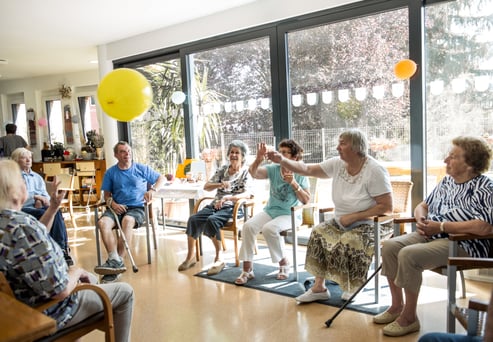 Throughout the past year, everyone’s wellness routine has been thrown upside down at some point or another. Maybe you figured out what your ‘new norm’ looks like, you are not sure where to start, or you are somewhere in the middle trying to find that new norm. A lot of the residents at the senior living community where I am employed are unsure of where to start, specifically after the pandemic.
Throughout the past year, everyone’s wellness routine has been thrown upside down at some point or another. Maybe you figured out what your ‘new norm’ looks like, you are not sure where to start, or you are somewhere in the middle trying to find that new norm. A lot of the residents at the senior living community where I am employed are unsure of where to start, specifically after the pandemic.
It felt like all at once, a handful of residents became aware of how far they regressed with taking the stairs, causing not only concern but also action. The residents were out at a Colts game or the symphony, had to take a set of stairs to their seats and came face-to-face with the harsh reality of how challenging the stairs were not only physically, but also mentally. We decided to add a “Stair Master” class to our group fitness schedule, which allowed the residents to learn proper biomechanics of taking the stairs, work on their capabilities twice a week, and have a support group that understood the struggles with the stairs. We had this class 2x per week for 4 months, each time focusing on the stairs in addition to strength, cardiovascular fitness, balance, and stability. Below are the three concepts we looked at each month to not only help evaluate if we were targeting what we wanted to target, but it was also used as an aide for residents to see their progress.
- Evaluation. There was no gold standard evaluation for out goals, so we made up our own evaluation. We wanted to overshoot what residents would typically have to do at an outing so regardless of how many stairs, they would be confident. The first Thursday of the month, we would perform 4 continual minutes of stairs and record the results. As the months went by, the residents had pride in how they felt as well as how far they had come along since the first evaluation.
- Intensity. Classes lasted 45 minutes, with a water break around the halfway point. We would consistently change when in the class we did the stairs, the duration spent on the stairs, and use work to rest ratios to help add intensity to the exercise without overloading the residents. If the stairs were added towards the end of the class, we found that residents were challenged more than if they were at the beginning of class. Overtime, going down the stairs presented a greater challenge, specifically mentally, and that allowed for our class to focus on overcoming mental barriers.
- Rate of Perceived Exertion. Once residents completed the 4-minute evaluation, we would ask them to rate their perceived exertion on a scale of 1-10. At the end of the 4 months, we saw the number of flights of stairs residents successfully performed did not increase exponentially, however their rate of perceived exertion consistently decreased.

.jpg?width=300&name=GettyImages-1157822544%20(1).jpg) We hear a lot about stability, but how do you accurately incorporate it into a client’s program? Understanding how to incorporate stability training will help keep your clients functional, independent, and healthy regardless of age.
We hear a lot about stability, but how do you accurately incorporate it into a client’s program? Understanding how to incorporate stability training will help keep your clients functional, independent, and healthy regardless of age.